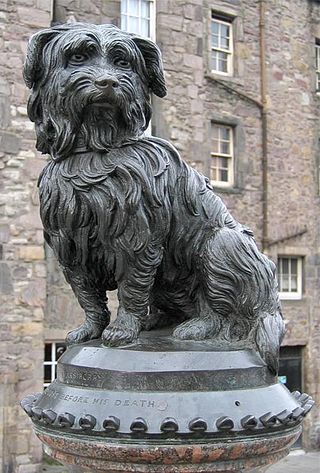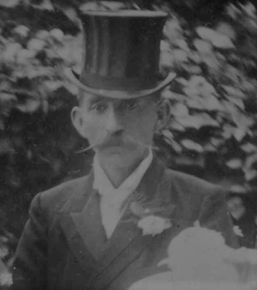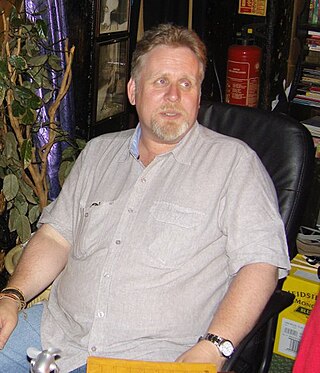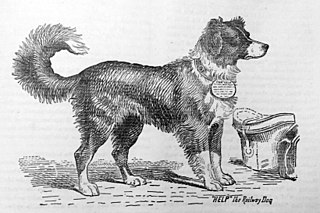
Daniel Lambert was an English gaol keeper and animal breeder from Leicester, famous for his unusually large size. After serving four years as an apprentice at an engraving and die casting works in Birmingham, he returned to Leicester around 1788 and succeeded his father as keeper of Leicester's gaol. He was a keen sportsman and extremely strong; on one occasion he fought a bear in the streets of Leicester. He was an expert in sporting animals, widely respected for his expertise with dogs, horses and fighting cocks.

Greyfriars Bobby was a Skye Terrier or Dandie Dinmont Terrier who became known in 19th-century Edinburgh for spending 14 years guarding the grave of his owner until he died on 14 January 1872. The story continues to be well known in Scotland, through several books and films. A prominent commemorative statue and nearby graves are a tourist attraction.

The Whitehall Mystery is an unsolved murder that took place in London in 1888. The dismembered remains of a woman were discovered at three sites in the centre of the city, including the construction site of Scotland Yard, the police headquarters. The incident belongs to the so-called Thames Torso Murders.

William Robertson FRSE FSA Scot was a Scottish historian, minister in the Church of Scotland, and Principal of the University of Edinburgh. "The thirty years during which [he] presided over the University perhaps represent the highest point in its history." He made significant contributions to the writing of Scottish history and the history of Spain and Spanish America.
Richard Whittington-Egan was a British writer and criminologist, the author of Liverpool Colonnade and Liverpool Roundabout, two colourful chronicles of Liverpool's historical characters, crimes and mysteries. A leading author on true crime over a long period of time, he is acknowledged also as an expert on Jack the Ripper.

Jack the Ripper was an unidentified serial killer active in and around the impoverished Whitechapel district of London, England, in 1888. In both criminal case files and the contemporaneous journalistic accounts, the killer was called the Whitechapel Murderer and Leather Apron.

Chief Inspector Donald Sutherland Swanson was born at Geise, where his father operated a distillery, before the family moved in 1851 to Thurso, and was a senior police officer in the Metropolitan Police in London during the notorious Jack the Ripper murders of 1888.

Joseph Lawende was a Polish-born British cigarette salesman who is believed to have witnessed serial killer Jack the Ripper in the company of his fourth victim, Catherine Eddowes, approximately nine minutes before the discovery of her body on 30 September 1888.

The World's End Murders is the colloquial name given to the murder of two girls, Christine Eadie, 17, and Helen Scott, 17, in Edinburgh, in October 1977. The case is so named because both victims were last seen alive leaving The World's End pub in Edinburgh's Old Town. The only person to stand trial accused of the murders, Angus Sinclair, was acquitted in 2007 in controversial circumstances. Following the amendment of the law of double jeopardy, which would have prevented his retrial, Sinclair was retried in October 2014 and convicted of both murders on 14 November 2014. He was sentenced to life imprisonment with a minimum term of 37 years, the longest sentence by a Scottish court, meaning he would have been 106 years old when he was eligible for a potential release on parole. He died at HM Prison Glenochil aged 73 on 11 March 2019. Coincidentally, he died on the same day the BBC's Crimewatch Roadshow programme profiled the murders.

Stevyn Colgan is a British writer, artist and speaker.
Edward "the boy" Jones was a Briton who became notorious for breaking into Buckingham Palace multiple times between 1838 and 1841.

Tarrare, sometimes spelled Tarar, was a French showman and soldier noted for his unusual appetite and eating habits. Able to eat vast amounts of meat, he was constantly hungry; his parents could not provide for him and he was turned out of the family home as a teenager. He travelled France in the company of a band of sex workers and thieves before becoming the warm-up act for a travelling charlatan. In this act, he swallowed corks, stones, live animals, and a whole basketful of apples. He then took this act to Paris where he worked as a street performer.
The Hundesprechschule Asra or Tiersprechschule Asra was an institution for performing dogs that existed in Leutenberg, Thuringia, Germany, from 1930 until near the end of World War II. Its Nazi talking dogs became a popular topic in the English-speaking press in 2011, when Jan Bondeson's Amazing Dogs: A Cabinet of Canine Curiosities used it as an example of Nazi-sponsored animal research.
Rolf was an Airedale terrier that was claimed to have been able to perform arithmetic and communicate with humans on an intellectual level.
Bernard Michael Oliver was a young British warehouse worker from Muswell Hill, North London. He disappeared on 6 January 1967, and his remains were found ten days later in the village of Tattingstone, Suffolk. His body had been cut into eight pieces and left in two suitcases. For this reason the crime is sometimes referred to as the Tattingstone Suitcase Murder. The case received widespread media attention, partly because police, unable to identify the body, took the unusual step of releasing a photograph of the victim's head to the media.
The Thames Torso Murders, often called the Thames Mysteries or the Embankment Murders, were a sequence of unsolved murders of women occurring in London, England from 1887 to 1889. The series included four incidents which were filed as belonging to the same series. None of the cases were solved, and only one of the four victims was identified. In addition, other murders of a similar kind, taking place between 1873 and 1902, have also been associated with the same murder series.

Help was a Scotch collie dog which gained fame through being used to collect money for charity.
James Thomas Sadler, also named Saddler in some sources, was an English merchant sailor who officiated interchangeably as a machinist and stoker. In 1891, the then-53-year-old was accused of killing prostitute Frances Coles. Sadler was placed under arrest, and a mob almost lynched him at the exit of a police station. Eventually, he was dismissed by police for having a solid alibi, and obtained compensation from a newspaper that had branded him as Jack the Ripper.
John Henry WishartFRCSEdFRSE was a Scottish surgeon who worked at the Royal Infirmary of Edinburgh. Although a general surgeon, he developed a special interest in the diagnosis and treatment of eye disease. He translated into English three major works of the Italian anatomist and surgeon Antonio Scarpa. With John Argyll Robertson, Wishart jointly founded the Edinburgh Eye Dispensary. He was surgeon in Scotland to King George IV and served as President of the Royal College of Surgeons of Edinburgh from 1820 to 1822.
Andrew Cook is a British author, popular historian, television presenter/consultant and former British civil servant. He specializes in early 20th century espionage history. He has produced well-received biographies of Sidney Reilly and William Melville.










